Evaluating AMD's TrueAudio and Mantle Technologies with Thief
by Ryan Smith on March 18, 2014 1:15 AM EST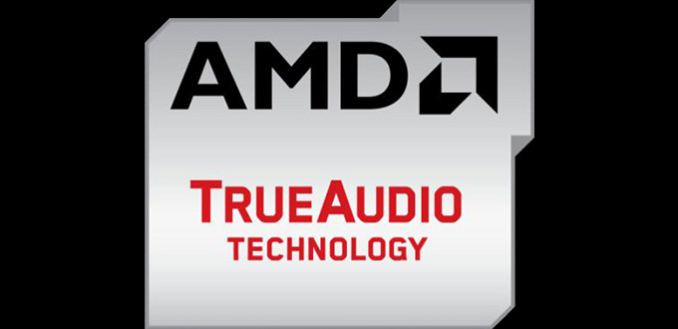
Scheduled for release today is the 1.3/AMD patch for Thief, Square Enix’s recently released stealth action game. Following last month’s Battlefield 4 patch, Thief is the second big push for AMD’s recent Radeon technology initiative, becoming the second game to support Mantle and the first game to support TrueAudio Technology.
Thief has been something of a miss from a Metacritic perspective, but from a technology perspective it’s still a very big deal for AMD and Radeon owners. As a Mantle enabled title it’s the second game to support Mantle and the first single-player game to support it. Furthermore for AMD it showcases that they have Mantle support from more developers than just EA and other Frostbite 3 users, with Square Enix joining the fray. Finally it’s the first Unreal Engine based game to support Mantle, which can be particularly important since Unreal Engine 3 is so widely used and we expect much the same for the forthcoming Unreal Engine 4.
But more excitingly the release of this patch heralds the public release of AMD’s TrueAudio technology. Where Battlefield 4 was the launch title for Mantle, Thief is the launch title for TrueAudio, being the first game to receive TrueAudio support. At the same time it also marks the start of AMD enabling TrueAudio in their drivers, and the start of their TrueAudio promotional campaign. So along with Thief, AMD is also going to be distributing demos to showcase the capabilities of TrueAudio, but more on that later.
Diving right into matters then, at the end of last week AMD was able to get the press access to today’s patch, giving us a short opportunity to look at Thief from both a Mantle perspective and a TrueAudio perspective. As this week coincides with GDC 2014 we haven’t had a ton of time to spend with Thief, so this overview is going to be relatively brief, but it has given us enough time to play with both of AMD’s technologies.
As this is a brief overview we’re going to skip recapping the technical details behind Mantle and TrueAudio. But if you haven’t read our previous works on those subjects, you can find more details on TrueAudio and Mantle in their respective articles.
Finally, launching alongside today’s Thief patch will be the latest rendition of AMD’s Catalyst drivers, Catalyst 14.3 Beta 1 (build 13.1350.1005). We don’t have a change log for these drivers at this point – expect one to be posted alongside the drivers today – but the important point is that these are the drivers intended to be used alongside the newly patched Thief and AMD’s TrueAudio demos.
| CPU: | Intel Core i7-4960X @ 4.2GHz |
| Motherboard: | ASRock Fatal1ty X79 Professional |
| Power Supply: | Corsair AX1200i |
| Hard Disk: | Samsung SSD 840 EVO (750GB) |
| Memory: | G.Skill RipjawZ DDR3-1866 4 x 8GB (9-10-9-26) |
| Case: | NZXT Phantom 630 Windowed Edition |
| Monitor: | Asus PQ321 |
| Video Cards: |
AMD Radeon R9 290X AMD Radeon R7 260X |
| Video Drivers: | AMD Catalyst 14.3 Beta 1 |
| Headphones: | Sennheiser PC 360 |
| OS: | Windows 8.1 Pro |
Mantle
First and foremost, let’s talk about Mantle. Whereas Battlefield 4 was primarily a multiplayer game, Thief is the first single player game to gain Mantle support. So although Thief isn’t the first Mantle game, by virtue of being a single player game it presents gamers and Mantle with a very different and much more tightly structured workload to work off of. Perhaps more importantly, since it is a single player game it has a much more consistent performance profile than Battlefield 4, and better still it even has a built in benchmark to go with it.
On the whole, Thief is a better than average game from a graphics technology perspective. It is a multi-platform title based on Unreal Engine 3, and at higher quality settings includes a number of graphical features such as tessellation, contact hardening shadows, and even supersample anti-aliasing (achieved through internally rendering at a higher resolution). However even with those effects, unlike Battlefield 4, Thief is much easier to CPU bottleneck. On our fastest video cards it tends to be SSAA (or very high resolutions) that leads to Thief being bottlenecked, allowing it to otherwise become CPU bottlenecked at 1080p without SSAA.
When it comes to being CPU limited, Thief’s preferences are clear: 4 cores with as much performance per thread as you can throw at it. This leads to Thief strongly favoring Intel CPUs – first the quads and then the dual cores – with AMD’s CPUs and APUs falling into place after that. As a result of these CPU bottlenecks Thief can trend very close to being a best case scenario for Mantle, so long as it’s not outright GPU bottlenecked.
With that in mind we quickly took a look at Thief’s Mantle performance on an R9 290X (Uber mode to rule out throttling) and an R7 260X to cover both a high-end GPU and a mainstream GPU. Furthermore we tested both of those configurations with a variant of the game’s Very High settings – dropping SSAA down to Low in exchange for 16x AF, alongside the game’s Low settings. Finally we ran the above against both a high-end CPU configuration of 6 cores/12 threads at 4.2GHz, and a low-end configuration of 2 cores/4 threads at 3.3GHz.
On a quick side note, AMD included the following notes with their instructions for testing Thief. In short, Mantle is up and running for all compatible AMD cards, but multi-GPU is not yet working, and memory management is in need of further optimization.
- Mantle performance for GPUs with 2GB framebuffers will receive additional optimization in a future application path for Thief™. Currently, these products may see limited gains in scenarios requiring large amount of video memory (e.g. maximum detail settings with SSAA enabled).
- Multi-GPU support under the Mantle codepath will be added to Thief in a future application patch
- As with other first-person titles, relatively smaller gains will be observed in GPU-bound scenarios
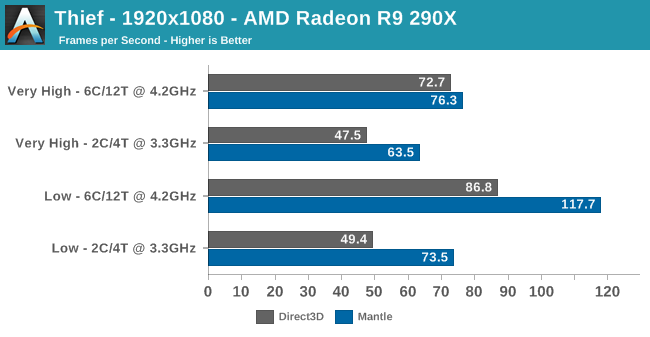
Looking first at the R9 290X, we can see that even at our modified Very High settings, there are still some small performance gains to be had from enabling Mantle. Switching out Direct3D for Mantle gets us another 3.6fps, or a 5% boost in performance. As we would expect however, a far more significant gain can be found when using Low settings. He we can see the 290X top out at 86.8fps with D3D – indicating that our earlier Very High settings weren’t all that far from being CPU bottlenecked – while Mantle boosts that up to 117.7fps, for a gain of 30.9fps or 36%.
From a practical perspective we would expect most 290X owners to be playing at settings similar to Very High, so the performance gains, though appreciated, aren’t especially influential in the long run. But it does give us some idea of what to expect.
Meanwhile if we start slowing down the CPU to just 2 cores at 3.3GHz, we can see the Mantle performance advantage grow. In this CPU bottlenecked scenario the performance gains from enabling Mantle are anywhere between 33% for Very High settings to a rather sizable 49% when using Low settings. This scenario, though contrived, makes for a good reminder of how significantly the current Direct3D rendering pipeline can bottleneck a GPU in the wrong (right?) circumstances.
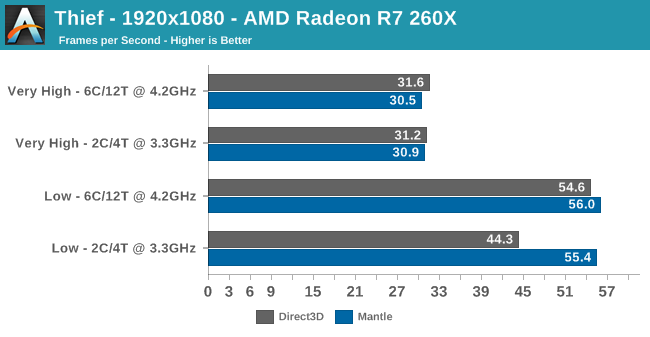
Moving on to the 260X, to no surprise we’re completely and utterly GPU bottlenecked with our Very High settings. The performance gains with Mantle are inconsequential at best, indicating that Mantle isn’t being used to significantly alter the rendering process on the GPU itself.
Shifting over to Low settings still leaves our setup GPU bottlenecked when testing against the 6 core setup, however we do see a very distinct performance gain on the 2 core setup. In this scenario enabling Mantle is worth an 11.1fps boost, or 25%, pushing the framerate up to 55.4fps.
Despite this being an artificial test on our GPU testbed, we would consider this to be a very real scenario overall given the price of the 260X. At $119 (MSRP) the 260X is very likely to be paired with a dual-core CPU or equivalent, so to see a meaningful performance gain in this scenario is promising. Whether any other Mantle-enabled single-player games will be this badly CPU limited remains to be seen, but if other games were to behave like Thief, then we may see similar gains on lower-end setups such as this.
Ultimately we’ve only had a limited amount of time with the Thief Mantle patch, so we’ll have to take a look at the competitive landscape another day. But as a pure Mantle analysis Thief is probably the greater beneficiary from Mantle at this time. The gains at the high end aren’t worth writing home about, but since we need the CPU to churn out a fairly high framerate regardless, there’s a much greater opportunity to benefit from Mantle on lower end Intel CPUs and AMD’s CPUs/APUs.


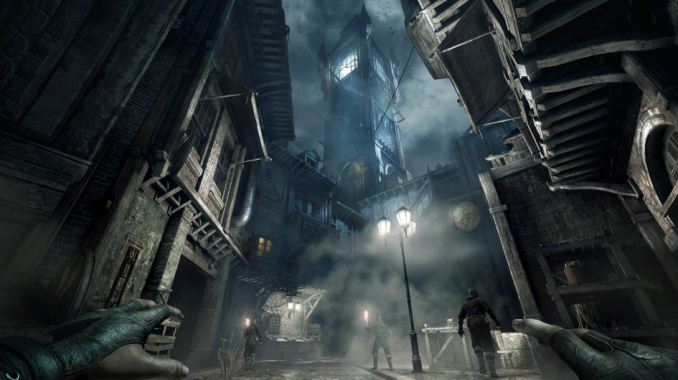
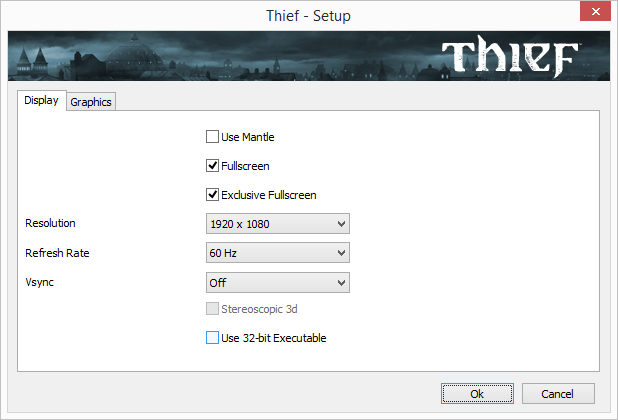









75 Comments
View All Comments
tynopik - Tuesday, March 18, 2014 - link
joying the fray -> joiningbut more on that latter -> later
also lots of places could have used some more commas:
launch title for Mantle Thief -> Mantle, Thief
along with Thief AMD -> Thief, AMD
unlike Battlefield 4 Thief -> Battlefield 4, Thief
Wwhat - Wednesday, April 2, 2014 - link
Sites should make separate closed comment section for such help tynopik, and then when they spot a reliable person assisting like you, give them access to it.That way they have free proofreading and improve their copy, to everybody's benefit.
Askilbrei - Tuesday, March 18, 2014 - link
I would be interested in what this would do for a low budget AMD cpu paired with a medium budget GPU.LarsBars - Tuesday, March 18, 2014 - link
+1It makes sense that AMD would use all of these "offload from the CPU" tricks when its CPUs are currently toward the bottom end of the pack.
TheElMoIsEviL - Thursday, March 20, 2014 - link
No, it really wouldn't make sense since AMD does have the extra CPU cores, in DX games, that generally remain idle. AMD do have the extra CPU resources available for audio.Problem is Direct3D and how much it sucks donkey nuts.
bsim500 - Tuesday, March 18, 2014 - link
Out of all the games that could potentially benefit from this, Thi4f is absolutely top of the list but has pretty much already flopped for a variety of reasons, ironically, one of which is a pretty crappy sound engine that still can't match a 1998 Looking Glass Studio game... Despite its epic franchise's history, Thi4f has an awful sound engine. Even the original game managed to more accurately replicate the effect of attenuation over different surfaces, etc. "Thi4f" somehow manages to screw it all up so that solid walls can make no difference in volume / frequency to a sound. It's also bugged in that one conversation 30ft away can jump in volume to match one 2ft away. All surfaces except glass & water now sound the same, etc. It's nothing like the stone vs wood vs tile vs moss vs grass vs metal, etc of the original. They can't even get the default music vs speech balance right with people complaining of not being able to overhear conversations in many sections.TrueAudio is promising, but it won't fix flawed psycho-acoustic programming in the core game which is the #1 key issue of "what sounds real". More audio channels won't make a game sound better unless devs spend a lot more time & money on realistic subtle sounds and learning to position & mix them well rather than just "slap more reverb on more surround sound explosions". 96-192khz sampling rates are pointless for everyone not sucked into audiophile snake-oil, etc.
I don't doubt that TrueAudio may provide some great effects in demo's, but really game devs aren't going to put in a lot of effort to perfect it since audio typically takes a back seat to the "Oooh! Shiny!" GFX obsessed brigade. After all, we're talking about the same devs who churn out games as quickly as possible and release them in a half bugged state and use "Day One Preorder" gamers as glorified beta testers just to save a few bucks on testing...
Many new technologies sadly end up unrealistic because the devs deliberately exaggerate them as a "showcase". With GFX we've had unrealistic bloom, DOF, etc, and with audio, usually they put in too much echo, and have limited ambient sounds for budgetary reasons. Think of real life - you often hear over 200 ambient sounds in the space of an hour. Now think games - you're lucky if you get 20 throughout the game. and the few you get are often overly loud or "crammed" into too small an area. The issue isn't really "GPU offloading", it's the psychology of developers.
bsim500 - Tuesday, March 18, 2014 - link
And just to add - if anyone's in any doubt over the attitude of developers making things "more real at any cost", with Thief 4, they took the 11 light gem visibility levels of the original, and dumbed it down to just 3 levels : "pitch black", "as visible as wearing a fluorescent yellow jacket in broad daylight", and "half-way between them"... It ain't the engine's that need over-hauling, it's the pervasive dumb-it-down-for-the-casual-audience attitude...velis - Tuesday, March 18, 2014 - link
I would disagree with your assessment: game devs already have to put A LOT of effort into sound, but ultimately it all comes off as cheap and useless crap because the audio engines themselves are crap.For a classic reverb sample: firing a gun in open grassland would normally generate little to no reverb while the same gun going off in a super-sized cathedral would generate tons of it.
The difference between a good sound engine and a bad one is that a bad sound engine gives you option to use reverb (and games today do when they think you're in a cathedral) and a good sound engine will take the sound source and run it against scene geometry. That way you'd still get lots of reverb for gun going off inside the cathedral even if you are standing a substantial distance away from the entrance.
The first problem with the above "good" audio engine is that each piece of geometry now also has to have all the sound properties (reflection / absorbtion / scattering / whatever) just like it now only has light properties. The second problem is that you need to push the geometry to audio processing unit as well as to graphics processing unit. What TrueAudio could offer is elimination of this dual transmission since this is supposed to be processed on the gfx card simultaneously.
Panzerknacker - Tuesday, March 18, 2014 - link
Nice article, I understand there is no time yet for a very big article because there are only 2 games supporting Mantle but good to see it making quite a difference in some situations. About TrueAudio, I agree there are very few games with outstanding audio, I hope this will improve. Ryan, have you ever played the original Bioshock? I think that game actually has the best audio of all games I've ever played, from a technical standpoint. I played it with a Creative Audigy 1 soundcard and 5.1 setup and the combination is absolutely astonishing. Maybe with headphones it will sound equally impressive.krumme - Tuesday, March 18, 2014 - link
Damn sad news for sound.Thanx for the subjective impression. Thats what matters. Hopefully in the future ps4 sales can drive devs to use this tech better.
How many play consoles with headphones?